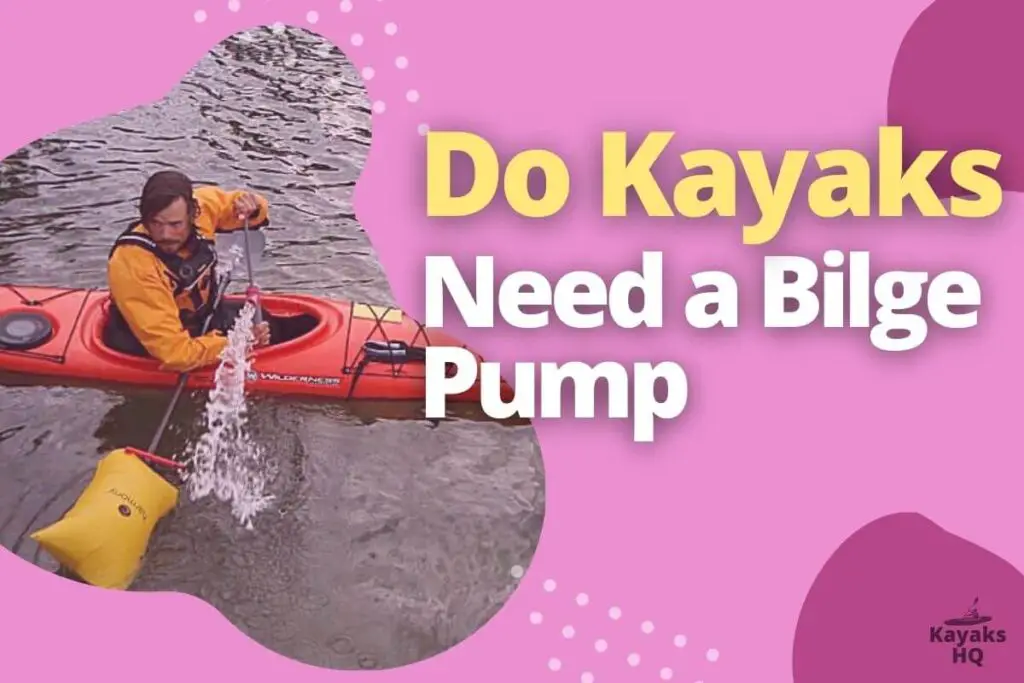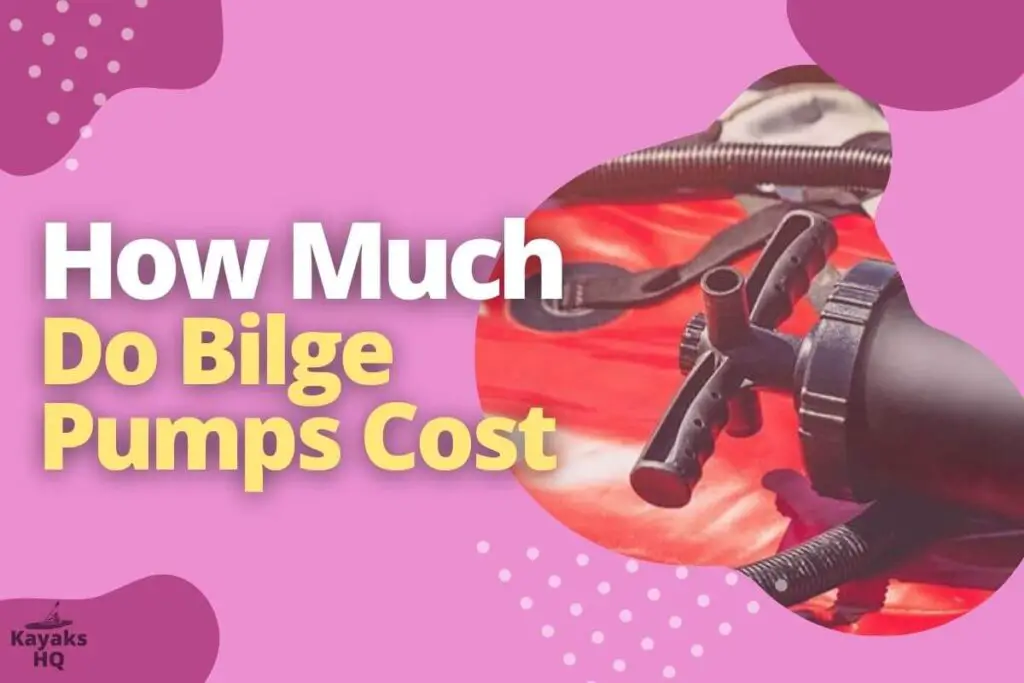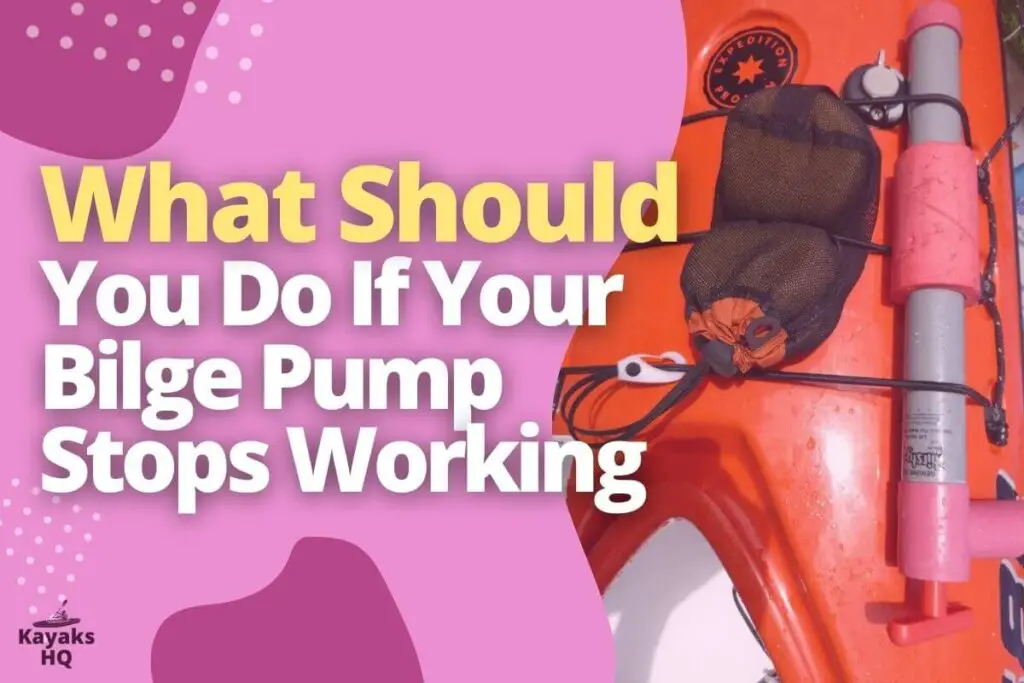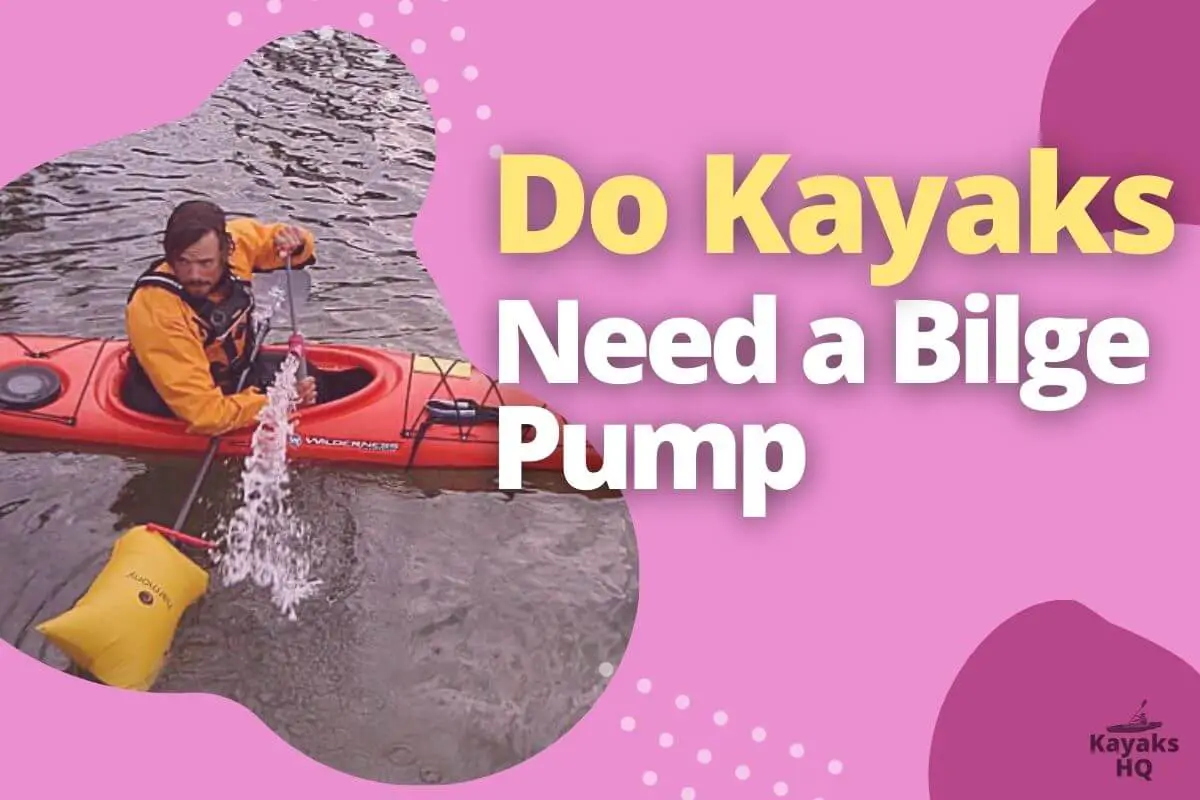Do you own a kayak? If so, you’re probably wondering if your kayak needs a bilge pump. Well, the answer to this question is yes, your kayak does need a bilge pump.
Kayaking is a great sport that allows you to enjoy the water. It’s also a great way to relax and unwind after a long day of work. But there are some risks with kayaking.
If you hook your paddle into something and it causes your boat to capsize, you could end up in the water. In this post, we will discuss why kayaks need a bilge pump and what kind of bilge pump you should get for your kayak.

Here’s The Answer To Do Kayaks Need A Bilge Pump
The answer is yes; kayaks need bilge pumps. They are a safety feature and a must-have accessory for any kayak. They are not expensive and easy to install, use, maintain and replace.
A bilge pump is a small hand pump designed to expel water from the bilge of a boat. They’re often called boat or marine bilge pumps. The term “bilge” refers to the lowest point of the inside of a boat, also known as the bottom or floor.
A bilge pump is an essential piece of safety gear for kayakers. It’s important to have a bilge pump on hand in case the boat springs a leak, floods or capsizes. Bilge pumps are typically small and can be stored easily when not in use.
What Are The Benefits Of Having A Bilge Pump On A Kayak?

A bilge pump is a device that is used to remove unwanted water from the cockpit of a kayak. This can be excess water that has accumulated from paddling in rough waters or simply water that has entered the kayak from the paddler.
- Having a bilge pump on a kayak can be extremely beneficial, especially for beginners, as it can help to keep the kayak afloat and prevent it from taking on too much water.
- There are many different types of bilge pumps on the market, but hand bilge pumps are the most common. These pumps are designed to be operated by one person, and they are usually very small and compact.
- This makes them easy to store on a kayak, and they can be used in an emergency situation. Bilge pumps can also be powered by batteries, but these are not as common.
- Bilge pumps are not required by law, but they are highly recommended by kayaking experts. This is because they can be a lifesaver in an emergency situation, and they can also help to keep a kayak afloat if it takes on a lot of water.
If you are planning on kayaking, it is a good idea to invest in a bilge pump.
Can You Use Any Type Of Bilge Pump On Your Kayak?
One type of kayak comes equipped with its own manual pump, but if yours does not have one built-in or if it’s broken, then there are plenty of other options available on the market.
What’s important is getting some sort of system installed so that even if your boat starts taking on water from an unexpected source (like when your paddle gets stuck in something), it won’t sink before help arrives.
Here’s a quick rundown of the different types of bilge pumps and what to look for when choosing one for your kayak:
- Hand Bilge Pump: These are the most basic type of bilge pump and are typically operated by a handle that you pump up and down. They’re small and lightweight, making them easy to carry with you on your kayak. But because they’re manual, they can be a bit tedious to use if you have a lot of water to pump out.
- Suction Bilge Pump: These bilge pumps are similar to hand bilge pumps, but they’re powered by a battery or other power source. They’re a bit more expensive than hand bilge pumps, but they’re much more efficient, making them ideal for larger kayaks or those that are prone to taking on water.
- Electric Bilge Pump: These are the most powerful type of bilge pump and are typically used on larger boats. They’re powered by an electric motor and can quickly pump large amounts of water. However, they’re also the most expensive type of bilge pump and can be difficult to install on a kayak.
Do You Really Need To Use A Bilge Pump For Your Kayak To Stay afloat?

Yes, you do need a bilge pump for your kayak. A bilge pump is an essential accessory for any kayaker and should be used as much as possible, both when on the water and off.
The first thing that you need to know about using a bilge pump is how to use it in case of an emergency situation.
It will fill with water and sink to the bottom of the body of water that you are in unless you use some sort of device such as a bilge pump or even just your hand if needed.
This can be extremely dangerous, so it’s best not to take chances in this situation! Another great reason why having one is important is because they can also be used while cleaning out your vessel before leaving shore after each outing.
Where debris may have found its way into nooks and crannies, which would otherwise be inaccessible without taking apart every piece individually by hand or paying someone else who knows what they’re doing (either way will cost money).
How to Use a Bilge Pump on a Kayak?
You should turn on your bilge pump before you get into the kayak so that it is ready to start pumping water out as soon as you are in. You can also use a bilge pump to pump out water from the paddle and/or kayak if you have one.
It’s critical that you understand how to correctly utilize it. The first step is to identify the location of the bilge pump. Most bilge pumps are located on the underside of the kayak, near the stern.
The next step is to identify the intake and output of the pump. The intake is the side of the pump that takes in water, and the output is the side that pushes the water out. In most cases, the output will be located higher than the intake.
Once you have located the intake and output, it is time to start the pump. To do this, simply insert the pump handle into the intake and start pumping. Pump the handle up and down in a smooth, continuous motion.
It is important to pump the handle slowly and steadily in order to get the maximum efficiency from the pump. If you pump the handle too quickly, the pump will not work as effectively.
Once you have started the pump, you will see the water start to flow out of the output. Continue pumping until all the water has been removed from the kayak.
Are There Any Safety Issues With Not Having A Bilge Pump On Kayak?
There are several safety issues with not having a bilge pump on a kayak. The following are some of the most common scenarios:
- You could sink. If your kayak fills up with water, it is likely that you will end up sinking and getting trapped underneath, which is not only dangerous but also scary as well.
- You could get hypothermia or be lost at sea due to cold weather conditions or darkness at night, resulting in injury or death if not rescued in time by fellow boaters who spot you from afar using their flashlights and flares respectively before they set off an emergency call for help using VHF radios (radio frequencies used for communication between boats).
- You could get injured from falling into rocks during rough seas when trying to climb back onto your boat after capsizing into them without any warning signs beforehand; these injuries could also lead them further away from land than originally intended once everyone else aboard decides whether they should search for someone else instead of saving themselves first before making sure everything’s okay with each other first before leaving this area behind forever due to lack of food supplies left behind while abandoning ship!
How Much Do Bilge Pumps Cost?

The cost of a bilge pump varies widely, depending on its size and how much functionality it provides. You can find an inexpensive pump for under $20.
But these tend to be small and may not be powerful enough to remove all the water from your kayak. On the other hand, more expensive models can cost upwards of $100 and sometimes even more than that!
The only other option is to purchase a “boat-in-a-box”, which includes all of your kayaking equipment in one unit for about $500-$600.
However, this may not be ideal if you’re planning on taking your boat out solo or if you have limited storage space available at home/work etc.
What Are Some Things To Consider When Buying A Bilge Pump?
- Pump capacity. The pump capacity of a bilge pump refers to how much water it can move in one minute, given the amount of pressure and flow rate provided by the onboard battery. The higher the wattage, the more water it will pump out in less time—and vice versa.
- Battery life. The length of time that a boat’s bilge pump can operate before needing to be recharged or replaced depends largely on its size and price point (more expensive models tend to last longer). Generally speaking, smaller pumps tend to last longer than large ones because they have fewer components inside that need power from an external source.
- Weight/size/waterproofness/price/noise level/compatibility/drain port/. The following aspects should be taken into consideration when purchasing a bilge pump for your kayak: First off is weight; if your kayak doesn’t already come with one built-in, then you’ll want something lightweight, so you don’t add unnecessary burden when carrying everything else required for a day on open waters!
What Should You Do If Your Bilge Pump Stops Working?

There are several things you can do if your bilge pump stops working. First, check the battery to make sure it is charged.
Next, check the power source by testing all of the fuses and switches with an ohmmeter. If everything looks good, then you must investigate further.
- Check All Hoses For Leaks: Check all hoses to make sure they aren’t cracked or broken anywhere along their length, which could lead to water seeping into them and eventually causing a major spillage inside of your kayak.
- Inspect The Pump: Look over your pump carefully for any obstructions that may be preventing it from functioning properly, like debris stuck inside or corrosion on its surfaces such as rust stains or mineral deposits.
How Often Should You Use Bilge Pump On Your Kayak?
You should use a bilge pump on your kayak a minimum of once a month. This will help to keep water from getting into the kayak and causing damage.
A bilge pump is an important tool for any kayaker and should be used at least once every month to prevent damage from occurring to the kayak or its contents.
If you plan on being out on open waters for extended periods of time, it may be advisable to use your bilge pump more frequently than monthly.
Bilge pumps are an essential accessory that can help prevent damage to your boat and its contents if there is water intrusion into the hull of the boat, whether through deliberate action such as capsizing or accidental actions like hitting rocks while paddling through turbulent waters.
Conclusion
In the blog post, a bilge pump is a device that is mounted on the bottom of a boat. It is used to remove water from the boat. The bilge pump is a critical piece of equipment that should be checked on a regular basis.
Make sure that the bilge pump is working properly by testing it every time you enter the water. Kayaks need a bilge pump for the same reason that boats do.
If a kayak or a boat is not equipped with a bilge pump, then it will accumulate a large amount of water, which can cause many problems. It can cause a kayak to sink and can even cause the boat to sink.
Thank you for reading this blog post. For more great content, be sure to check out our other blog posts and keep following us for more topic updates.

